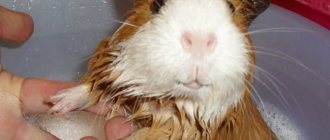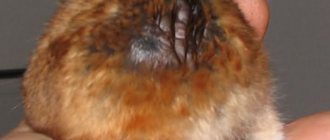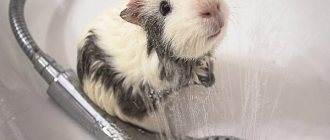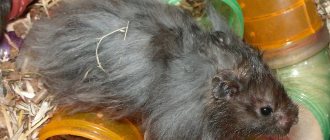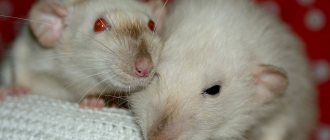Do rats like to swim?
Domestic rats are descended from pasyuki. These animals are not afraid of water, but rather calmly swim in it and hunt. However, wild rats clean their fur in natural conditions using teeth or sand.
Pet rats' reactions to water depend on their temperament. Some rodents like water procedures, while others are terribly afraid and do not like to wash themselves.
Let's look at it in more detail
Cases when you can bathe this rodent:
- the rat ate something inedible and subsequently got dirty in it.
- from lying for a long time on a bedding that is no longer fresh, the pet smells unpleasant.
- the rat does not clean itself, does not wash itself, is unkempt (although this is rare, it can still happen)
- if the rat has parasites.
- The animal is already old, it is difficult for him to take care of himself, or due to illness.
- found in males: the rat's tail is unkempt.
- There are rats that simply love water treatments.
This is interesting: How to choose the optimal size dog for your home?
When to wash a rat and when not to
Although it is not necessary to wash the rodent, in some cases it is necessary to clean the rat's fur yourself. So, when should you carry out water treatments for a rodent?
The procedure may be needed if your rat:
- something sticky in the wool;
- wool in a toxic substance such as varnish or paint;
- a skin condition that requires a veterinarian-prescribed medicated shampoo (such as mite infestation or bacterial/fungal infections).
In other cases, washing the rat is not necessary, since it is able to clean its fur on its own. However, it is strictly forbidden to wash a rat if there are certain diseases or weather conditions.
You should not wash your rat if it has the following problems:
- wounds on the body, since upon contact with water and steaming they can become inflamed;
- the rat has a cold or has recently recovered. Water procedures can cause complications or a long recovery for your pet.
What to do if your pet is afraid of water
Some rats are afraid of water. This is expressed by anxiety, the desire to escape, and aggressiveness. The animals begin to scratch and break out. In this case, you need to take time to accustom them to taking water procedures.
First you need to show the rat that you can play with water. Water is poured into a flat container and, under the supervision of the owner, the animal is allowed to experience the new environment. You can lightly wet his fur. The rodent is then fed a treat to give it a pleasant experience.
Fear of swimming may not arise because of the water, but due to a change in environment. The noisy sounds of a pouring stream and the loud voice of the owner cause anxiety in the rat. If your pet is actively vomiting while washing, you can get an assistant.
Caring for and maintaining a rat requires attention and knowledge from the owner. Bathing is optional, but can be done regularly if your pet likes to frolic in the water. The main thing is to ensure safety and a comfortable environment.
Source
Preparing a bath for a rat
Once you have determined that your rat needs to be bathed, you will need a few supplies, as well as preparing utensils and water before washing your pet.
The process of taking a bath for a rat is more complicated than for a person. You need to have everything ready before you start.
- Shampoo for rats.
Pet stores and online stores offer a wide range of shampoos and care products. There are products designed specifically for small rodents, and kitten shampoo is safe to use due to its sensitive formula.
- Container for the procedure.
You can use a small bowl of water (such as a bunny bowl or other shallow bowl) to bathe your rat. You can also use small saucepans. It is necessary to lay a cloth at the bottom of the container to prevent the animal from slipping.
Before the procedure, you need to let your pet get used to the bath. Allow the rat to spend time in it without water, and then fill the container to 5 cm.
- Optimal water temperature.
If you want to give your pet rat a bath for the first time, it is recommended that you do it in the summer. This way, your rat will be more likely to accept the water and see it as something positive and enjoyable.
If you can't wait until summer, use water at a temperature between 37 ºC and 38 ºC. Teach your little friend to contact with water, which should always be at a comfortable temperature.
- Towel.
You will need two large hand towels to place in the sink and drying drawer.
It is best to use pet towels such as dog towels designed for grooming.
Precautionary measures
If a rat appears at home and you have no experience caring for it yet, then you should prepare for certain difficulties that can be expected at certain stages. The most exciting moment will be bathing your pet, especially for the first time. To protect yourself, you should wear something with long sleeves, in case the animal is not in the mood or is not ready for contact with water. If possible, it is better to ask a qualified person to show you exactly how to bathe and tell you about all the nuances.
Precautionary measures should be taken not only in relation to the owner, but also for the pet itself. If the rat is still small and has not had the opportunity to get acquainted with water, it is necessary to create optimal conditions for this, evoking positive emotions from the new element. If you neglect these recommendations, it may be very difficult to wash your pet in the future, especially if it really needs it.
Although water procedures are carried out infrequently, it is necessary to know about those situations when they should not be used, otherwise there will be much more harm than good. It can be difficult for a non-specialist to notice any minor health problems in a pet, which is why life-threatening situations arise.
To avoid this if possible, it is worth knowing about the main reasons that prevent rats from bathing.
How does the washing procedure take place?
Now that everything is set and ready, let's look at how to wash your rat.
- Remove the rat from the cage and place it in a container of water. If possible, have your pet sit on a towel at the bottom of the container. This will help your rat feel calm and prevent him from slipping.
- Then either wet the dirty areas of the fur or pour water from a small cup onto the dirty areas. Use as little water as possible.
- Now take a small amount of shampoo and gently apply it to the coat. It is important to carry out the procedure as quickly as possible to reduce stress in the rat and protect it from hypothermia.
- When you're done shampooing, take a rag or small cup and pour water over the washed coat until the shampoo is completely rinsed out.
When thinking about how to bathe your rat, it is important to avoid getting water on the face and ears. Apply water to the body, not the head or face, unless directed by your veterinarian.
- Rat head.
A rat's head should not be washed, as water may get into the ears or eyes. However, you can wipe the head and face with napkins or damp pads.
- Rat tail.
The rat tail should be cleaned separately. Wet paper towels or unscented baby wipes work well for quickly cleaning the tail.
If you decide to add a little mild soap to the paper towels, make sure the tail is thoroughly rinsed afterwards. Don't leave any soap residue.
The easiest way to wipe your tail consists of three steps:
- Hold the rat tightly to your body with one hand.
- With your other hand, wrap a towel or napkin around your ponytail.
- Swipe down. During this process, you may hear a squeak of protest, then try to calm the rat with your voice.
General rules
It is necessary to wash a rat at home correctly; its well-being depends on this. Before embarking on water procedures, it is worth studying the specific situations in which these measures are necessary:
- getting dirty with waste that was not removed from the cage in time;
- the appearance of any parasites on the animal’s skin or fur;
- if the pet is not eager to take care of its fur on its own;
- a few days before the exhibition.
To make the bathing process safe, you should be fully prepared for the procedure. You need to have a container with you that will be suitable for bathing, shampoo for rats or rodents and towels for drying. You should not use laundry or ordinary soap, regular or baby shampoos, since the composition there is much more aggressive than in specialized products.
If only the rat's tail is dirty, then you should not bathe it completely; it will be enough to wipe only the tail part using a damp sponge and baby cream. When planning water procedures for your pet, you should know that you cannot expose it to running water, since contact with the aquatic environment will be unexpected and extremely unpleasant for the pet, which will provoke stress and fear of such procedures.
Another danger of such bathing will be moisture getting into the ears, which the pet simply will not have time to fold properly to protect itself, as happens in nature.
Bath
To prevent the bathing procedure from causing panic and fear in your pet rat, it is necessary to gradually accustom it to the procedure. First of all, you should choose the right bath in which your pet will bathe. Its depth and width should be such that the rat feels confident and can get out of the container if such a desire arises. To prevent bathing from causing fear, it is initially better to accustom your pet to the bath by lowering it there for a few minutes, and when the animal gets used to it, you can gradually add water to it.
It is important not to pour a lot of water into the bath; the rat should be on its paws while bathing and calmly move around the container in any direction. If you add all the water at once, there is a risk of frightening the pet, in which it will begin to scratch and can injure both itself and its owner.
With the optimal amount of water, there is no significant risk that it will get into the eyes and ears of the animal and harm it. If the bath is overcrowded, then the possibility of incorrectly bathing the rat increases significantly.
Water temperature
In addition to the correct amount of water, you also need to monitor its temperature. This is important both for the animal’s comfort during bathing and for its subsequent health. If the parameters are incorrectly selected, the rat may become stressed during the procedure and become ill after its completion. The optimal temperature for swimming will be within 36-37 degrees.
You should not prepare two containers to bathe your pet, because the water in them will have different temperatures, which will negatively affect the condition of the animal. To avoid foaming the bath water too much, it is better to use a small amount of shampoo while lathering, so that it can be quickly and effectively rinsed off.
It is not necessary to wash a rat's face, because they themselves constantly wipe it throughout the day. By choosing the right container, accustoming the animal to it and setting the temperature correctly, you can bathe the rodent efficiently and provide it with appropriate care. Girl rats can be bathed once a month. Male rats should be subjected to this process twice or given additional wipes weekly using hypoallergenic wet wipes.
Accessories and tools
The right bath and the right water temperature are very important criteria for the bathing procedure, but accessories and means for it are also of significant importance. The rodent's body is covered with thin skin, which can be easily injured if too much force is applied. In addition, like many other similar animals, the skin has a protective layer that helps in a variety of situations and maintains normal health for the rat. If you use the wrong shampoos and washcloths, there is a risk of damaging the protective layer, and in the worst case, the skin itself.
It is best to bathe your rat using a small, very soft washcloth and brush. With their help, it is possible to reach all hard-to-reach places and wash them thoroughly. As for the products, you should use exclusively specialized shampoo for rodents, which is designed taking into account all the characteristics of the fur of these animals and their skin.
If you use soap or another product, you can disrupt the normal condition of the skin, which will cause irritation, itching, and affect the fur.
Bathing
To carry out the bathing procedure correctly, you must have with you:
- bath;
- shampoo;
- towel.
All components are prepared in advance and tested for suitability and convenience for the rodent. If possible, you should check the water with a thermometer or dip your elbow into it. The optimal mode will be 30-35 degrees on the thermometer or the feeling of warm water, if you independently determine its temperature. About 5 cm of water is poured into the bath, and then the rat is placed there.
The bathing procedure is as follows:
- the pet’s fur must be carefully moistened, making sure that the face and ears remain dry;
- foam the shampoo on a washcloth or using your fingers, and carefully apply it to the fur, gently massaging it;
- Using a washcloth, carefully rinse off the shampoo with water from the bath.
After bathing, be sure to dry the rodent until the fur is completely dry. If a rat is afraid of water, then you should not force bathe it, this will only increase its fear. It is important to carry out preparatory measures that will allow the animal to get used to the aquatic environment and be calm in it. The owner should pour a little water into a saucer or other spacious low container so that the animal can run freely in such conditions.
After playing, it is very important to treat the rat with his favorite treat, which should also be given at first after each bath.
Drying
The drying process is no less important than the bathing itself, because the pet’s health depends on it. If you don't dry your rat's fur or dry it poorly, it may catch a cold. When planning water treatments, it is important to check the room for drafts and, if possible, eliminate them in order to protect the animal. When preparing for a swim, you should have at least two paper towels and one soft cloth towel with you.
With the help of paper products, it is possible to quickly remove the bulk of the water that remains on the wool after bathing. Once the excess has been removed, you need to wrap the animal in a cloth towel and keep it there until it is completely dry. There is no need to rub the fur; this will be unpleasant for the rodent and can harm its skin or protective covering.
To ensure that your pet sits quietly after bathing and does not struggle, you should treat him with something tasty and talk in a soft voice, calming him down. Having endured several such procedures, the rat gradually gets used to it and is more peaceful about such care, which significantly speeds up and makes the task easier for the owner.
Drying
It is important to dry your pet completely after washing. If you skip this step, your rat may get sick.
Dry the rat with a towel until it is almost completely dry. If the weather is cool, turn the hair dryer on cool setting and low speed and dry it thoroughly. Hold the nozzle at least 30cm away from the rat's body, holding it in your other hand, and ruffle its fur to dry it.
However, the rat may be unhappy with this procedure or even afraid. Then you should offer your pet his favorite treat. Also try talking to the animal in a calm tone and calming it down. Under these conditions, washing fur can become a rat's favorite pastime.
Disinfection equipment
You need to be absolutely meticulous when cleaning your rat's cages, toys and accessories. It is your duty to keep it clean so that your pets do not get sick. It also keeps your house from smelling like a zoo.
Wash food and drink containers every day. . Wash the cage well every week. There are several cage models that are dishwasher safe. Small steam washers are not too expensive and can also be used. It goes without saying that people who have large steam machines can do a great job of disinfecting their little pet's cages...
0
You may also be interested
How and what to feed your pet rat: diet, recommendations
In addition to bathing, you need to be responsible when feeding your rat. Many of us think that these animals need to be fed only with vegetables and some grains. However, in reality these statements are incorrect. The diet of rats must be balanced.
Approximate diet of domestic rats:
- Moreover, the diet differs significantly from that of a human or even a cat. It is completely wrong to feed rats exclusively grain products because their diet must also include animal ingredients such as meat and fats.
- Therefore, we recommend giving your rat fruits, vegetables, and meat products. However, under no circumstances should you feed them sausage, smoked meats and fried cutlets. It is allowed to give chicken or pork meat, and it should be lean and boiled.
- That is, there should be no other heat treatment other than cooking. Fermented milk products have a very good effect on the health of domestic rats. Skim milk, low-fat cheeses, cottage cheese, and homemade yogurt without additives are suitable for this.
- Please note that rats need to be fed dairy products with a reduced amount of fat. You should not give legumes to rats, as well as Brussels sprouts and cabbage. They can negatively affect the functioning of the gastrointestinal tract.
- It is very useful to give rats walnuts or peanuts. Under no circumstances should you give almonds or cashew nuts. If you do not have time to prepare full lunches and dinners for your animal, you can purchase specialized and ready-made food.
Light
Rats are nocturnal animals, and other things being equal, they prefer to be in dark places and go out in search of food at dusk and in the dark. However, they easily and quickly adapt to light, and if they do not encounter any dangers in illuminated places and in bright rooms, they quickly cease to be afraid of light. Often, rats become diurnal and forage in daylight.
This means that although in general rats are afraid of light, it will not be possible to use this as a permanent repellent. If you leave the light on in the room, then after a few days the animals will stop paying attention to it.
On a note
Interestingly, due to the specific nature of their vision, rats do not perceive infrared light. In zoos, this is used to switch nocturnal rodents to daytime mode: during the day a red light is on in the enclosure, and the animals believe that they are in the dark, and at night a regular incandescent lamp is turned on, and the rodents go to sleep. As a result, visitors during the day can observe animals that lead a nocturnal lifestyle.
Preparing for a swim
Before you take the animal and go to wash it, you need to prepare everything you need. In addition, this procedure should only be carried out when the animal is in a good mood. It is advisable, before bathing, to check how the nibble generally relates to water, perhaps it will like it, or, on the contrary, it will be very frightening, in order to know what to do next.
For this test, you should wet the fur coat a little, but only so that it does not get on your head. If the rat behaves quite calmly and no changes in behavior have occurred, then you are lucky, and the animal loves water.
But when he begins to break free and resist in every possible way, then you will need to be patient. Remember that it is better to take small containers so that the rat can feel the bottom with its paws. Also, don't add too much water.
The process will be much easier if you prepare all the necessary supplies in advance:
- You will need several containers into which warm water is poured. The temperature of the water is very important; it should not be cold or hot. The water should be 30°.
- Shampoo.
- Be sure to have several towels.
- Instead of a washcloth, use a soft cloth; you should not use any brushes, as this can damage delicate skin.
As already mentioned, there should not be a lot of water, pour enough so that the rat can stand on its own paws.
Contraindications
Among the factors that are not in favor of swimming, it is worth highlighting two main categories.
Factors that carry a low degree of risk to your pet’s health:
- danger of respiratory diseases in case of improper bathing or drying;
- under-dried fur and hypothermia in water lead to colds;
- water in the ears and eyes leads to diseases of these organs;
- Too frequent bathing and the use of inappropriate detergents cause changes in the protective layer, dry skin and irritation.
There are also factors that are more dangerous:
- the presence of scratches and wounds on the body, which steam out if water slowly gets on them, and this leads to itching and inflammation of the skin;
- the presence of a cold or a post-cold condition, at such a moment it is better to do without swimming, otherwise the risk of complications after an illness increases several times, and the recovery procedure is delayed for several weeks.
Thus, we can judge that bathing is a safe and acceptable procedure for rats if it is carried out according to the rules, without overusing the frequency of bathing and using only the necessary means.
In case of any deviations from the norms, it is worth understanding the reasons in detail and solving them, postponing any water procedures for some time. If the pet is completely healthy, tolerates being in water well and is active after bathing, then there is no reason to worry , otherwise, you need to evaluate the need to use water, and sometimes eliminate it altogether, switching to wet wiping with napkins and sponges.
You will learn more about how to bathe a rat at home in the following video.
Breed standard
These are the types of rats that are most often kept in your home. The rodent looks very cute. The elongated body reaches up to 30 cm. Plus the tail is 20 cm. The weight of females is 300 g, and that of males is 500 g. The paws are covered with hair. There are 4 toes on the front paws and 5 on the hind paws. The ears are small and rounded. The short, smooth coat boasts its shine and lack of bald spots. On the elongated head there are eyes - shiny and clean beads.
Chemicals against rodents
When talking about what odors repel rats and mice, do not forget about household chemicals and some flammable materials. Mice and rats are afraid of:
- bleach and chlorine-containing products;
- turpentine;
- kerosene;
- gasoline.
Petrol
But using these means to repel rats is inconvenient and sometimes dangerous for people and pets. After all, they will also have to breathe in caustic fumes, and in the case of kerosene, gasoline and turpentine, the possibility of an accidental fire cannot be ruled out.

